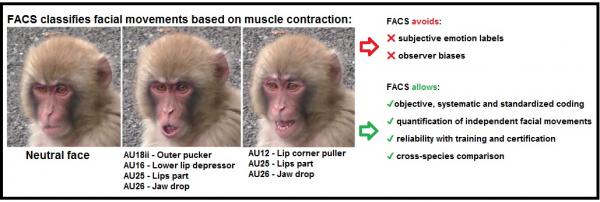



|
TOPICS BONOBO Chimpanzee "Ai" Crania photos Itani Jun'ichiro archives Open datasets for behavioral analysis Guidelines for Care and Use of Nonhuman Primates(pdf) Study material catalogue/database Guideline for field research of non-human primates 2019(pdf) Primate Genome DB 
Primate Research Institute, Kyoto University Copyright (c) |
Japanese Development of a MaqFACS extension tool for the objective measurement of facial expressions in Japanese macaques
Catia Correia-Caeiro, Kathryn Holmes, Takako Miyabe-Nishiwaki
Abstract
Facial expressions are subtle but complex movements that animals use for communication and emotional expression. However, studying facial expressions in animals in a scientific way is a difficult task due to a variety of factors. For example, humans process faces as a whole and do not detect the subtle facial movements. Furthermore, different species can display similar facial expressions that have opposite meanings (e.g. teeth exposure in humans is linked to positive situations, whereas the same facial expression in chimpanzees is linked to negative situations). The well-known human FACS (Facial Action Coding System) is the gold standard for objectively measuring facial expressions in humans, and has been adapted for cross-species systematic comparisons using the muscular anatomy as a basis. Previous work has developed FACS for several species, including chimpanzees (ChimpFACS) and rhesus macaques (MaqFACS). Thus we developed a FACS extension for Japanese macaques, following established FACS methodology: first, we considered the speciesăŕ facial muscles; second, we compared facial muscles and movements to other species to determine each muscle function; and finally, we categorised each independent facial movement into Action Units (AUs). We documented 19 AUs, 15 Action Descriptors (ADs, i.e. broader movements) and 3 Ear Action Units (EAUs) in Japanese macaques. Due to the high similarity in facial muscles between rhesus and Japanese macaques, we developed a MaqFACS extension for Japanese macaques, which when used together with the MaqFACS, comprises a valuable objective tool for the systematic and standardised analysis of facial expressions in Japanese macaques. The MaqFACS extension for Japanese macaques will now contribute to the investigation of the evolution of communication and emotion in primates, as well as contribute to improving the welfare of individuals, particularly in captivity and laboratory settings.  References:
Correia-Caeiro C, Holmes K, Miyabe-Nishiwaki T (2021) Extending the MaqFACS to measure facial movement in Japanese macaques (Macaca fuscata) reveals a wide repertoire potential. PLoS ONE 16(1): e0245117. https://doi.org/10.1371/journal.pone.0245117 2021/01/22 Primate Research Institute
|